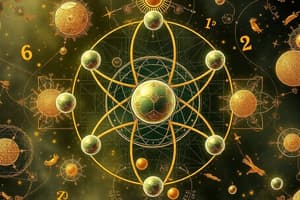Podcast
Questions and Answers
What is the basic unit of a chemical element?
What is the basic unit of a chemical element?
- Molecule
- Atom (correct)
- Electron
- Neutron
Which of the following particles carries a positive charge?
Which of the following particles carries a positive charge?
- Nucleus
- Proton (correct)
- Neutron
- Electron
What determines an atom's chemical identity?
What determines an atom's chemical identity?
- Number of electrons
- Number of protons (correct)
- Atomic number
- Number of neutrons
Which subatomic particle helps stabilize the nucleus by balancing the positive charge?
Which subatomic particle helps stabilize the nucleus by balancing the positive charge?
What is the function of neutrons in an atom?
What is the function of neutrons in an atom?
Which particles are found in the nucleus of an atom?
Which particles are found in the nucleus of an atom?
What determines an atom's chemical properties?
What determines an atom's chemical properties?
Which of the following quantum numbers specifies the shape of an atomic orbital?
Which of the following quantum numbers specifies the shape of an atomic orbital?
What is responsible for governing electron behavior in atomic orbitals?
What is responsible for governing electron behavior in atomic orbitals?
How are elements arranged on the periodic table?
How are elements arranged on the periodic table?
What are the negatively charged particles found in an atom's electron cloud?
What are the negatively charged particles found in an atom's electron cloud?
Which rule governs how electrons fill atomic orbitals with the same energy level?
Which rule governs how electrons fill atomic orbitals with the same energy level?
Study Notes
Unraveling the Mysteries of Matter: Atomic Structure in Chemistry
At the heart of every molecule and substance, you'll find the building blocks of our world: atoms. To understand chemistry and the behavior of matter, it's essential to grasp the principles of atomic structure. Let's delve into the world of subatomic particles and the fundamental model that explains how atoms are constructed and function.
Atoms: The Tiniest Units of Matter
An atom is the basic unit of a chemical element. It's composed of three particles: a nucleus in the center and a cloud of electrons surrounding it. The nucleus is made up of two types of particles: protons and neutrons. Protons carry a positive charge, while neutrons are electrically neutral. The number of protons determines an atom's chemical identity (called atomic number), as every element has a unique atomic number.
The Nuclear Atom
The nucleus is a dense, positively charged region at the atom's center. It consists of protons and neutrons. Protons attract electrons, which counteract the repulsive forces between them. Neutrons have no electric charge and help stabilize the nucleus by balancing the positive charge.
Subatomic Particles: Protons and Neutrons
The nucleus is made up of two types of particles: protons and neutrons. Protons have a positive charge and are responsible for an atom's identity (atomic number). Neutrons carry no electric charge, but their presence affects an atom's mass and stability.
Electrons: Negatively Charged Particles
Electrons are the negatively charged particles in an atom's electron cloud. They orbit the nucleus in energy levels called shells or orbitals. The number of electrons in an atom's outermost shell determines its chemical properties.
The Periodic Table and Atomic Structure
The periodic table arranges elements in order of increasing atomic number. This organization reveals periodic trends in chemical and physical properties. The table also shows the number of electrons in each element's outermost shell, which correlate with the element's chemical behavior.
Atomic Orbitals and Quantum Mechanics
Atomic orbitals are mathematical functions used to describe the possible positions of electrons in an atom. These orbitals are specified by four quantum numbers: principal, angular momentum, magnetic, and spin. The Pauli exclusion principle and Hund's rule govern electron behavior in atomic orbitals.
In conclusion, understanding atomic structure is essential for grasping the basic principles of chemistry. The atom's composition, subatomic particles, and their behavior in orbitals, all contribute to the diversity and interactivity of the elements that make up our world.
Studying That Suits You
Use AI to generate personalized quizzes and flashcards to suit your learning preferences.
Description
Explore the fundamental concepts of atomic structure in chemistry through this quiz. Learn about subatomic particles, the nuclear atom, electron configurations, the periodic table, and quantum mechanics principles like atomic orbitals and quantum numbers.




